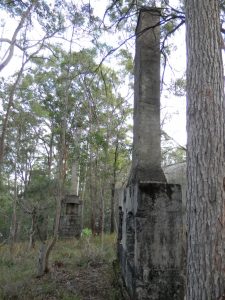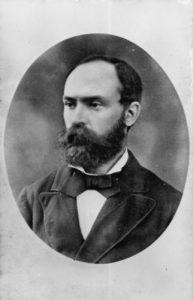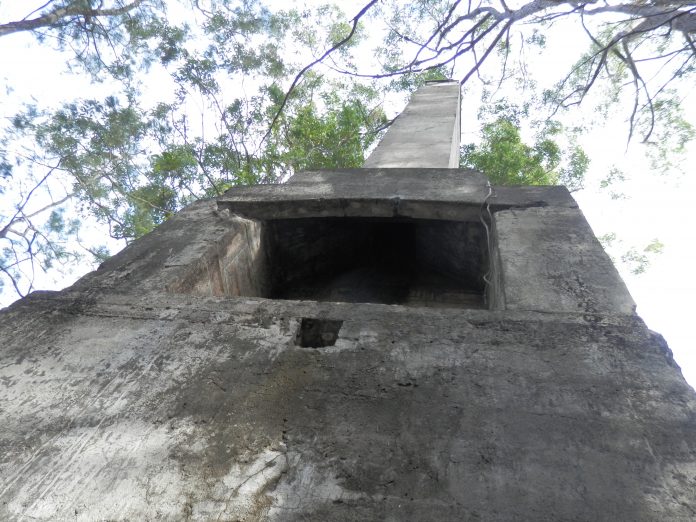Hidden in bushland on the Sunshine Coast, two brick chimneys are all that remains of an ambitious but ill-fated plan to build a sanatorium north of Brisbane in the 1880s.
Newspapers of the day reveal little about the project which ended before it began, when bushfires swept through the area on top of the hill near where houses now line Forest Oak Court at Tanawha.
The timber building was destroyed before a fire could be lit in the grates or a patient admitted. Two tall chimneys among the trees are the only proof it ever existed.
The first clues come from the Maroochydore Advertiser of May 31, 1961 when a report by the Maroochy Shire Health Inspector G.R. Orr, on the site “approximately 400 yards west of the Buderim Mountain-Bruce Highway intersection” was printed:
“Mr George Burnett (aged 81) one of the oldest residents of the area was approached and recalled the course of events through the years.
“The chimneys, constructed of brick and mortar formed part of a 22-room structure erected by Dr Rendle as a convalescent home. Work on the building commenced in 1880, (this is more likely to be 1884) materials being transported from the south firstly by ship to a landing in the Mooloolah River known as the Old Banana Shed, and thence to the site by bullock waggon.

“In 1885, Mr Burnett at the age of five, accompanied his father to an auction sale of furniture and effects occasioned by the failure of the venture. The building remained unoccupied for years being eventually destroyed by fire some 50 years ago.
“The chimneys, approximately 30ft (9m) and 22ft (6.7m) high respectively each have two fire places suggesting they were located in walls dividing rooms. Fire bricks used in the chimneys bear the brand “Campbell”. The remains of house stumps are also discernible among the trees.
“Despite the ravages of time the chimneys are in good state of repair.
“Should council consider preservation of the chimneys for posterity it would be desirable to have large trees removed from the vicinity, perhaps fence a small enclosure and erect a suitable plaque.”
Nothing much happened after that until 1992, when Nev Wilson was subdividing his property and agreed that the prime elevated site of the chimneys would be part of his parkland dedication so they might be retained for posterity.
Love history? So do we. Help keep more Coast memories alive by subscribing to our free daily news feed. Go to Subscribe at the top of this story and add your name and email. It’s that simple.
“Photos of the chimneys which now stand eerily in the middle of the bush surrounded by tall trees, have been examined by council officers who hope to eventually create an historic site for visitors,” it was reported. “Mr Wilson said it appeared that there had been one big timber building which had burnt down and that there had also been a blacksmith’s forge on the same site.
“Floor joins are visible on the chimneys. ‘It appears they were constructed with the building and no scaffolding was used. I imagine it would have had a high-pitched ceiling’, he said.”
Robert Sly of Montville, whose father bought the Tanawha property from Buderim pioneer Bert Guy in 1918, also helped fill the gaps. He knew the building was not a hospital but a sanatorium, and that he had spoken to the daughter of Dr Rendle in the 1950s, although her memories were hazy as she had only been a child at the time.
“It was quite a pretentious place in those days but it was no sooner completed than it burnt down. It was never used at all,” Mr Sly said.
The building is credited to Dr Richard Rendle (pictured), a Wickham Terrace surgeon and apothecary who took up a selection of 642 acres (260ha) of Portion 201 Parish of Mooloolah on March 26, 1884, and was granted freehold title in January 1889.

He had arrived in Brisbane in 1876, as Surgeon Superintendent on board the Queen of Nations.
Dr Rendle was active in Brisbane society, and in 1888 unsuccessfully ran for the seat of Moreton, campaigning on sanitation.
He was also on the board of management of Mutual Life association of Australasia, alongside Samuel Griffith, Queensland premier 1883-88 and a principal author of the Australian constitution, and Henry James Oxley.
Dr Rendle never lived at Tanawha but he employed three bailiffs (Thomas Daniell, Charles Simmonds and Josiah Box) to satisfy the conditions for selection and carry out the required improvements.
In 1886, he became the Secretary of the newly-formed Medical Society of Queensland and was prominent in Brisbane society before his empire collapsed and he went into liquidation in 1894. Whether the Tanawha project contributed to his downfall is not known.
Dr Rendle died at Kingaroy, where he had recently moved and “was very popular”, on August 10, 1907.
Little was written about his Tanawha sanatorium, but the chimneys still stand tall as ghosts in the bushland, recalling the heyday of the ambitious Dr Rendle.
This flashback is brought to you by veteran Sunshine Coast journalist and history writer Dot Whittington, also the editor of Your Time Magazine.





